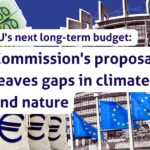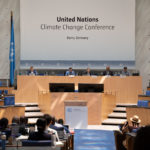Comparing funds mobilised vs. climate investment needs to 2030
In 2020, the EU increased its 2030 climate target from 40% emission reductions to at least 55% net emission cuts (compared to 1990 levels). To back it up, in 2021 the European Commission has revamped its entire climate and energy framework under the ‘Fit for 55’ package, which is gradually making its way through the various legislative processes at EU level. While at the time of writing the ESR, RED and EED are still being negotiated, their ambition will increase to align all individual pieces of legislation with the net 55% emissions reduction target which is enshrined in the EU Climate Law. The new targets proposed by the European Commission aim at reducing ETS emissions by 61% and ESR emissions by 40% by 2030. Finally, the recent ‘REPowerEU’ strategy sets even more ambitious targets as well as the need to frontload investments for achieving a fast phase out of the EU’s dependence on Russian fossil gas.
Consequently, National Energy and Climate Plans (NECPs) will need to be revamped between 2022 and 2023 as they fall short to achieve the new EU targets of a 55% emissions reduction by 2030, let alone a 65% emissions reduction target by 2030 that would be aligned with Paris Agreement commitment[i]. Beyond 2030 targets, NECPs are also crucial for Member States to ensure energy security and energy justice. As the European Commission flagged in its ‘‘REPowerEU’’ package, NECPs can provide a powerful “framework for planning and encouraging the reduction of use of fossil fuels”. Member States should use NECPs as a tool to ensure coherence and consistency across concrete plans to wean off Russian gas imports as soon as possible, to stop using fossil fuels overall, as well as to ambitiously curb energy demand, ramp up sustainable renewables and roll out flexibility options.
Meeting ambitious targets through revised national contributions and ensuring a swift transition away from fossil fuels to tackle the current energy crisis, will in turn require a significant mobilisation of climate and energy transition investments, to meet additional investment needs. Given the crucial contribution of EU funds to public investment in several Member States, the extent to which (a) National Recovery and Resilience Plans (NRRPs), which detail how Member States intend to spend funds from the Recovery and Resilience Facility, and (b) Partnership Agreements (PAs) and Operational Programmes (OPs), which detail how Member States will spend funds from the Cohesion Policy, will contribute to achieving more ambitious climate targets is central.
Indeed, as evidenced in this report, the RRF and Cohesion Policy funds combined make up for a very large fraction of dedicated EU funds that can be mobilised for financing climate and energy transition related investments.
As such, through an empirical assessment of investment plans in NRRPs and OPs respectively, the present report provides a preliminary quantification of their contribution to 2030 targets for a sample of 7 Member States that are significant recipients of EU funds. To what extent are investments mobilised via NRRPs and OPs sufficient to meet climate and energy related investment needs for achieving ambitious 2030 climate targets, and address the need to phase out the EU’s reliance on fossil fuels?
Although previous reports have assessed the contribution of EU funds to filling climate and energy transition investment needs, those have relied on assumed spending shares for those investments. The present report is instead based on actual spending plans. Further, it focuses specifically on climate and energy transition related investments that are directly targeting emissions reduction, and not a comprehensive assessment of all environmental dimensions of spending plans (e.g. climate adaptation and biodiversity). A broader assessment of recovery plans can be found in a previous CAN Europe and Bankwatch report.
Finally, the findings of the present report should be treated as preliminary as several Operational Programmes are still at a draft stage, or incomplete regarding the information disclosed. As such, the present analysis will be complemented as more information becomes available and the totality of plans finalised.
Notwithstanding caveats, the main conclusions of this preliminary report are that:
- The total funds mobilised by a sample of Member States through the most important EU funds for financing climate and energy transition investments represent a limited fraction of total investment needs for achieving 2030 targets.
- There are significant variations among Member States in terms of how much funding is mobilised for the climate and energy transition related investments in respective NRRPs (for what concerns the use of RRF funds) and OPs (for what concerns the use of European Structural and Investment Funds). This equally suggests there is significant room for improving spending plans, notably given the new impetus of ‘REPowerEU’.
- Despite variations, there is a very substantial investment gap remaining for achieving a 55% emissions reduction target let alone a Paris Agreement Compatible 65% emissions reduction target by 2030.
- A combination of measures is required for filling the investment gap remaining. These measures range from spending plans-specific adjustments, such as redirecting climate harmful spending lines that remain in respective plans, to more systemic reforms for catalysing additional public investment both at the national and the EU levels.



